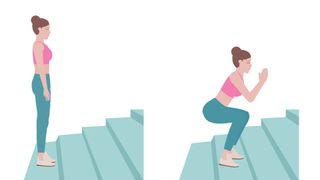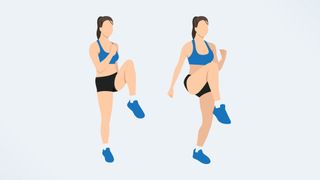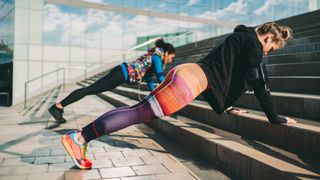You don’t need a stairclimber or weights for this five-move lower-body workout, just a set of stairs and your body weight.
There are plenty of benefits of climbing, like building stronger quads, hamstrings, glutes, hips and calves, and even recruiting your core muscles simultaneously. Uphill climbs are brilliant for activating your back body (known as your posterior chain) and increasing engagement in your lower back, glutes, and hamstrings, which is why you see them cropping up in treadmill warm-ups.
However, if you're like me and don’t find staring at a wall particularly fun while you exercise, you can forgo the gym and take the stairs for this 30-minute muscle-torching session. If you’re looking for a simple but effective staircase workout from home without equipment, you can strengthen your core and legs this way instead.
What are the 5 staircase exercises for your lower body and core?
1. Squat jumps

Squat jumps develop your explosive core and leg power, recruiting your fast-twitch muscle fibers responsible for movement like sprinting and jumping. Add a few pulses at the bottom of the squat to make the exercise more challenging.
How:
- Start at the bottom of the stairs with your feet hip-width apart and legs straight
- Bend your knees to perform a squat, sitting below parallel with your chest proud and back straight
- Brace your core, then jump on to the first or second step, landing with bent knees in the squat position
- Ensure both feet are planted. As you drive upward, jump onto the next step and repeat
- Once you reach the top, run down the stairs and start again.
2. High knees

High knees recruit the legs, hips, and core and increase your heart rate, adding a cardio element to your routine.
How:
- Start on the bottom step with feet hip-width apart and legs straight
- Drive your right knee upward to at least hip or chest height, then as you lower your leg, land your right foot on the next step
- Drive through your right leg, then drive your left leg upward and repeat on the left side
- Continue to the top of the staircase, then run down and start again.
3. Bear crawls
Bear crawls are just one of many animalistic exercises in calisthenics and animal-based movement flows. You’ll crawl on all fours up the staircase, then reverse all the way back down if you feel confident, alternating arms and legs, or run down the stairs and start from the bottom again.
How:
- Start on all fours at the bottom of the staircase with your feet on the bottom step hip-width apart, knees bent, and hands a few steps up with arms straight
- Step your right hand and left foot up the stairs one step, then repeat with your left hand and right foot
- Keep your core braced and back flat as you climb, one foot and hand at a time.
4. Plank

Isometric contraction is a brilliant, low-impact way to engage muscles from head to toe without moving up and down the stairs. Enter, the plank.
To make the exercise easier, hold your plank facing toward the top of the stairs (pictured); to make the exercise harder, face your head toward the bottom of the stairs, loading more of the chest, arms and shoulders, similar to the starting position of a decline push-up.
How:
- Start in a plank position with your shoulders stacked over your wrists and hips aligned with your shoulders
- Brace your core, glutes, and shoulders and consciously squeeze as many muscles as you can
- Send your gaze toward your fingertips to keep a neutral neck
- Hold the position, then lower your knees to come out of the plank.
5. Single arm and leg planks
Alternating arm and leg planks challenge balance, stability and coordination. Try to keep your shoulders and hips square to the stairs without twisting to one side. If this feels too challenging, practice raising one arm, then one leg and switching sides. Progress the move by facing toward the bottom of the stairs and regress the exercise by facing toward the top of the stairs.
How:
- Start in the plank position as above, bracing your core, glutes and shoulders
- With control, slowly lift your right arm and left leg into the air. Keep a flat back without arching your spine or twisting to the side
- Pause once your right arm reaches shoulder height and your left leg reaches hip height
- Return to the plank and switch sides.
5-move staircase workout to try:
This workout follows a 50-second on and 10-second off format.
Complete as many reps as you can in the first round, then try to maintain the same reps or more across the remaining rounds. Aim for 6 rounds, totaling 30 minutes.
Start with the squat jumps, then high knees and bear crawls, all for maximum reps. During the plank and alternating plank, aim to hold for the full 50 seconds.
Staircase workout benefits:
These bodyweight exercises torch the legs, glutes, hips and core without weights. You don’t need a yoga mat, dumbbells, or the best kettlebells, either, but you could add them to up the ante if you desire.
Like step-ups, stair climbing works your core muscles to help stabilize your torso and drive powerful movement. Collectively, the core supports your spine and pelvis and helps generate motion, so it makes sense climbing engages these muscles pretty heavily.
Climbing could even help you live longer. Research, re-published to the European Society of Cardiology (ESC) explains that a meta-analysis of nine studies found stair climbing was associated with a 24% reduced risk of dying from any cause, and a 39% “lower likelihood of dying from cardiovascular disease.”
Another study reported by Medical News Today found people who climbed 50 stairs during the day reduced the risk of cardiovascular disease by 20% compared to those who didn’t.
More from Tom's Guide
- Forget running, 7 full-body strength exercises you can do on your treadmill
- Best treadmill workouts
- No Reformer? Pilates instructor shares abs workout to sculpt your core at home using one foam roller





















 English (US) ·
English (US) ·